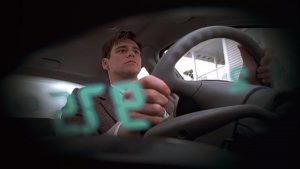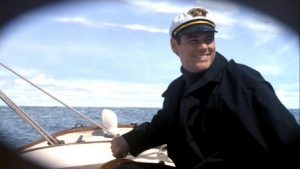Most avid moviegoers or chronically tardy people have likely had the experience of arriving late to a movie showing. They hustle to their seats while trying to determine if the previews are still going or the main feature has already started. The latter task can be challenging in an era where blockbuster films bear little difference from the initial previews and advertisements. After seeing explicit advertising for the theater’s concession stand and future films, we get a subtler plug for the next film in the franchise, a line of action figures, or a ride at the studio’s theme park. With strong dependability, you can expect every film to sell something. The Truman Show (1998), however, would seem to defy that expectation. Released amid the rise of reality television, it promises to critique such programming and the values and consumption it promotes. And the film strives so much towards this promise that the viewer can easily see it as a radical alternative to and attack on the usual propaganda of the film industry. Under this interpretation, it satirizes the use of product placement and the superficial perfection of suburban life, among other things. Fatally, this interpretation ignores the simple truth that The Truman Show is yet another product—a commercially successful one at that—of the film industry, and to think that the industry would ever criticize itself or change its ways is wonderfully naïve.
The film centers around the title character, Truman, who by all accounts holds the pieces a perfect American life: a tidy house with a picket fence in suburban community, a beautiful wife, and a job selling insurance. But, his life is all a 24-hour reality show, captured on thousands of hidden cameras within a massive dome that contains his whole world. Truman is the only one unaware of the reality, with the rest of people in his life being paid actors under the direction of Christof, the producer of the show. After several unusual events—a studio light falling from the sky, a voice on the radio tracking him—he begins to suspect that the world around him is not what it seems. The film ends with him sailing to the edge of the dome and walking out an exit door.

At first glance, it is perfectly reasonable to treat the film as a subversive critique of media. The writer, Andrew Niccol, had previously written Gattaca (1997), which questions the role of technology in our lives, and the director, Peter Weir is known for thought-provoking films. Many film critics fell into this trap, with Rita Kemply of the Washington Post calling it “subversively entertaining satire”[1] and Peter Travers of Rolling Stone perceiving a “penetrating meditation on the forces that control our existence.”[2] These reviewers confuse provocation with subversion: a film can make you think but limit that thinking to realms that fall well within the norms that the entertainment industry enforces. The Truman Show might make you wonder if you are actually the star of a reality show or even kindle a secret desire to be so, but it will not prompt any real thought about the conditions that actually confine us. The confusion regarding the film originates from the bold way it sets about reinforcing a common narrative. Normally, a work of popular culture simply outlines the values it seeks to reproduce. A sitcom, for example, will depict a typical American family and derive humor from occurrences that fall mostly within the usual realm of life. The viewer watches it and, as a result of absorbing the included ideological blueprint, learns to play his or her role in family life. But The Truman Show explores the idea that someone could be in a sitcom but think that it is real life. Ultimately, this twist has little impact of the views propagated in the film.
That the viewers might applaud the film industry for criticizing itself is in fact a goal of the film. Ronald Bishop, a professor of Communication at Drexel University, writes that “films like Truman are created and packaged by entertainment companies as a means to exploit, and at the same time dissipate, our desire to engage in genuine media criticism.”[3] You can walk away feeling that you watched something critical and cutting-edge, but that is only because the filmmakers want you to feel that way. In generally unfulfilling lives, people love the idea that they are engaging in a subversive action. The entertainment industry, being charged with enforcing normality through media, must give people a false, controlled outlet for subversion so that they do not engage in any real rebellion. On a more practical level, perception that the film industry has some self-awareness gives people hope that they can safely continue to consume the industry’s products with no risk of being subjected to propaganda.
Every film or story presents a real issue,[4] and to the best of my knowledge, no one today is actually stuck in a dome as the unwilling star of a reality show, so the real message is something else. The situation is the same but the agent is different; we are trapped in our lives, but by media, corporations, and everyday routines. The symbolism is striking: television controls Truman’s life just as media controls ours; Truman is adopted and owned by a corporation just as capitalism owns most aspects of us. Another guard against Truman’s escape is his fear of water, carefully crafted by the show’s creators through the maritime death of his father. In a place entirely surrounded by water, this fear represents a fear of the unknown, which advertising and entertainment has cultivated in us. Behind the intriguing show-within-a-movie setup are the conditions of real life, indeed exaggerated, but still hitting too close to home perhaps. In the film, the reality show uses product placement to avoid having to stop for ads, so Truman’s wife must regularly turn to the camera and pitch the latest product she has bought. Outside the film, such a situation exists only in an adverting executive’s wildest fantasies, but it echoes the advertising found in our music, art, and high school gymnasia. Truman’s routine is almost comically identical each day. On the way to work, he always wishes his neighbors “good afternoon, good evening, and good night” then gets stopped by two men who always push him into a billboard featuring a rotating advertisement. The only discrepancy between his world and ours is that his fellow people are happier while doing the same thing everyday, but we must remember that in the film they are paid to—or in Truman’s case, don’t know any better—whereas we are beaten into submission, which tends to produce less merry results.
So what’s the solution to all this, to a monotonous life under the control of capitalist media? According to the film, you can just leave. Truman overcomes his fear of water and starts sailing away from the island. Once the Christof locates him, the producer engineers a storm in attempt to capsize the boat and dissuade Truman from continuing his escape. Eventually Christof ends the storm and allows Truman to sail to the edge of the dome, where he finds a door and exits. But this ending is not a triumph of the ordinary person over those who control him or her. Once Christof accepts that Truman is going to leave, he lets him, and directs the camera angles to ensure that Truman looks heroic while doing so. And while Truman’s captivity easily relates to our own, his escape does not offer a real solution because there is no door marked with an exit sign. Baring life on a desert island, for most of the film’s audience, there is no feasible alternative to media and capitalism.

The fantasy that the film produces is not one of escape but of living in a world like Truman’s, that is, a perfect one. This seems counterintuitive, but that is just a product of the film’s masking of its ideological bent. Those arguing against me would point to Truman’s escape as an example for the viewer to follow. But his escape is meaningless both due to the previously mentioned lack of feasibility and his awareness. It’s hard to long for escape when you do not even realize you are trapped. Christof says in an interview that people accept their surroundings by default, and based on the story of Truman, a switch away from the default requires extremely odd events. The viewer is not meant to follow Truman as a leader but instead dream of having his perfect life at the beginning then be glad to avoid his fate at the end. After all, who wants to risk his or her life escaping the perfect place? The ending scene is the one place where the true goals of the film peek out boldly from behind the curtain of self criticism, as Cristof makes an impassioned plea for Truman to stay in the perfect, “real” world of Seahaven. The musical score during his speech, sappy end-of-movie music, accentuates his argument and creates a sense of finality. As the final plug for the film industry’s views, the Hollywood executives would have probably preferred to end the film there, but the plot mandates Truman’s escape. The film still makes one last appeal for Seahaven life with the image of Truman leaving a celestial bed of clouds for a door into darkness.

The visuals throughout also further the fantasy. From the opening of the film, the most visually striking aspect is the setting. The white picket fences surrounding pastel-colored houses with cupolas and the brick streets filled with pedestrians and bicyclists all present the image of perfection. But this is not a perfection created in a studio in Hollywood; it is a real town in Florida. The filmmakers only had to fictionalize it slightly—changing the name from Seaside to Seahaven—and, voila, the set already existed. The irony is that in this film, a real place plays a studio whereas the opposite usually holds true. The use of this setting, however, goes beyond the location scouts doing an astute job; the fantasy that the film creates can actually be a reality. As long as films have been able to construct a world unlike our own, the viewers have wanted to go there. Places like Disneyland and Universal Studios exist to satisfy this desire, and based on the astronomical attendance at these destinations, the desire is quite strong. The Truman Show creates a desire for the suburban communities that are scattered thickly across the country and of which Seaside is the poster child.

The Truman Show teaches us that we have to be careful about how we watch films, especially when we think they might be questioning other media or the ideals that media enforces. We can let down our guard slightly at film festivals and art museums, but once money and big studios involved, caution is advised. Moreover, The Truman Show represents an especially clever packaging of its message in that the viewer can easily enjoy the film for its “edginess”—and superior quality—while also absorbing its ideology. In many ways, this cleverness is scary; the film is almost 20 years old, and, with the rapidly advancing strategies of advertising and messaging, one can only imagine what the film industry has been doing to us for the past two decades.
[1] Kemply, Rita, “‘Truman’: The Camera Never Sleeps,” The Washington Post (1998)
[2] Travers, Peter, “The Truman Show”, Rolling Stone (1998)
[3] Bishop, Ronald. “Good Afternoon, Good Evening, and Good Night: The Truman Show as Media Criticism.” Journal of Communication Inquiry 24, no. 1 (2000): 6-18.
[4] Jameson, Fredric. Political Unconscious: Narrative as a Socially Symbolic Act. Ithaca: Cornell University Press, 1982.